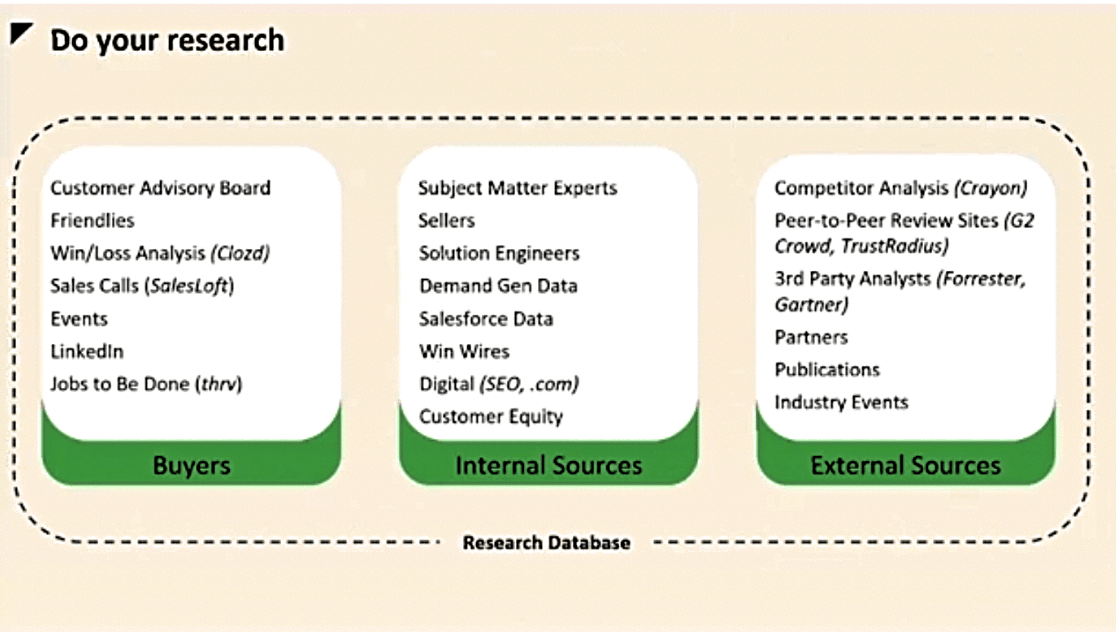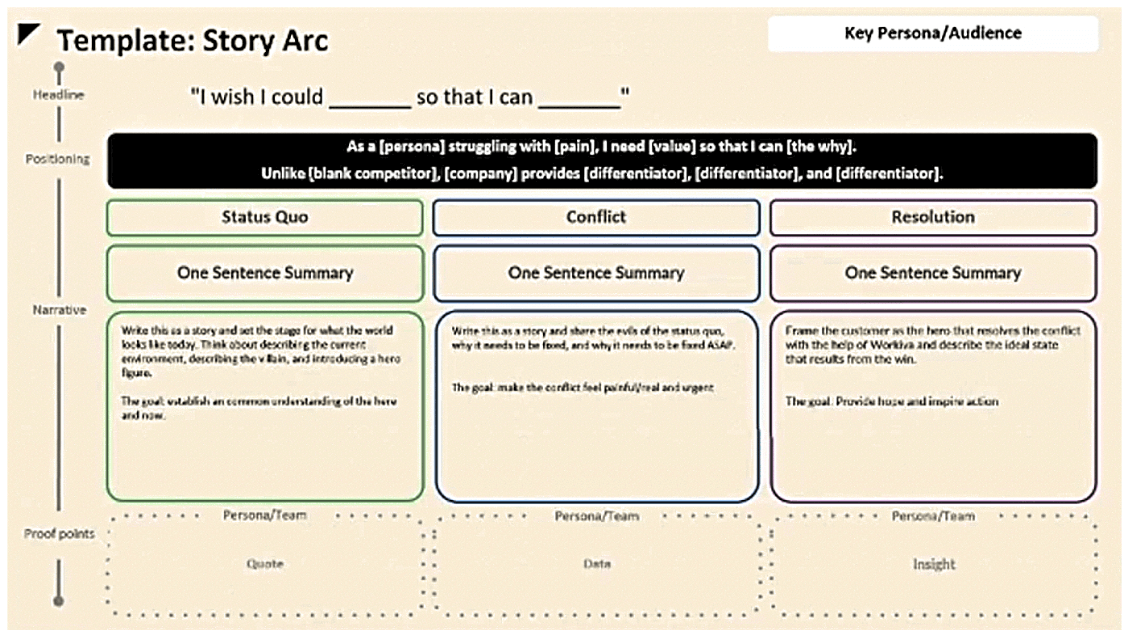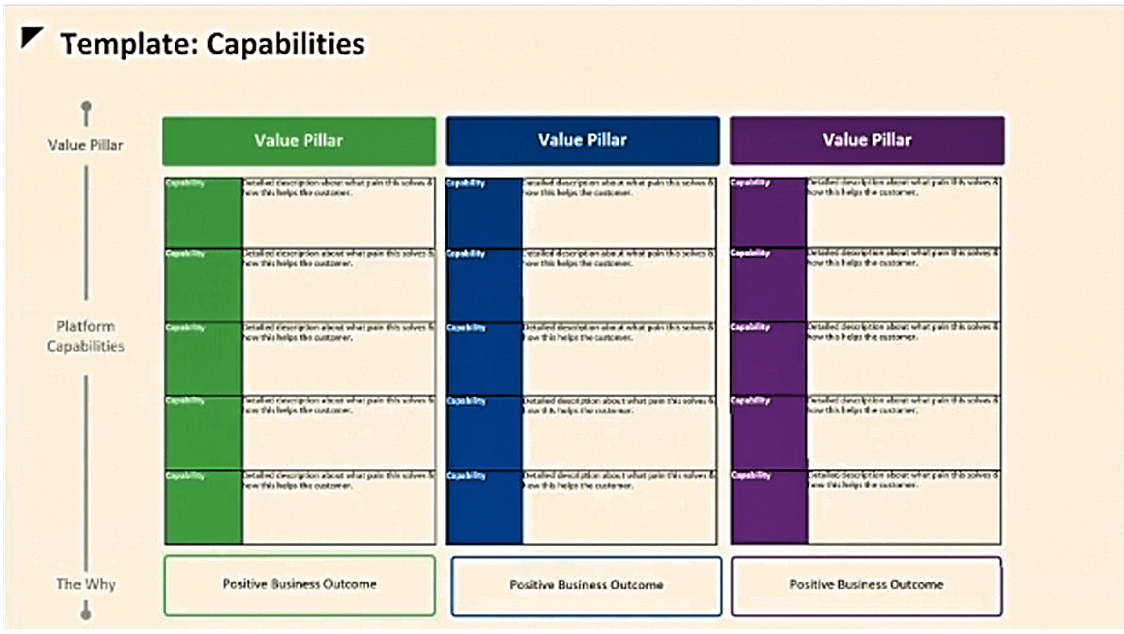Hi, everyone! I'm Dana, part of the product marketing team at Workiva. Today, we'll be discussing five tips to take your messaging to the next level.
But before we dive in, let me quickly share a little bit about my background. I began my career in accounting and finance before transitioning into product marketing.
Ever since then, I've been working exclusively with B2B SaaS companies, and I'm currently a member of the portfolio marketing team here at Workiva. In my role, I focus primarily on marketing strategy, in alignment with other marketing functions like demand generation and messaging.
I’ll explain how product marketing is organized at Workiva. We have the traditional product marketing team, which focuses on sales enablement and competitive intelligence for individual products. The portfolio marketing team brings together different products based on specific personas. This approach allows us to create a more scalable go-to-market strategy.
Alright, let's take a peek at the five messaging tips we'll be exploring today:
- Clearly define your target audience.
- Don’t underestimate the importance of research.
- Standardize with a messaging framework.
- Involve stakeholders early and often.
- Don’t just set it and forget it.
Let’s dive in with our first tip.
Tip number one: Clearly define your target audience
This may seem obvious, but it's the most crucial aspect of messaging. I didn't prioritize this enough when I started doing messaging.
As product marketers, we tend to get caught up in the product itself – the features, capabilities, and all the benefits they offer. However, effective messaging requires a deep understanding of who we're trying to reach and persuade.
Always start with the ‘who.’ Make it clear which segment you’re targeting, whether that's based on industry, vertical, company size, or specific solution group personas. At Workiva, we're currently focused on our core personas, while also considering layers like company size and the industries where we have the most success.
I would recommend leveraging your demand generation and pipeline data, as well as win-loss analysis, to refine your target audience. Without knowing your audience, it's impossible to understand their needs and pain points and demonstrate empathy, which is key to capturing their attention.
The second reason why identifying your target audience is crucial is for differentiation. In today's market, there are so many similar products, and feature comparisons often reveal only minor differences that don’t matter much to customers.
Unless you have a massive marketing budget or true innovation that sets you apart, segmentation is the most powerful tool for differentiation and capturing a specific market segment.
Let me give you an example. About a month ago, while driving, I noticed a billboard that read, "Get SOC 2 compliance in weeks, not months." I like that messaging because it appeals to a specific need of the target audience by emphasizing the value of time.
A couple of days later, a thought leader in my field of audit risk and compliance posted on LinkedIn, "If I were hiring a vendor for third-party SOC 2 services and wanted to ensure controls were up to snuff, I don’t think I’d put speed as a high evaluative criterion for me. But hey, maybe that's just me." This was in direct response to the ad I’d seen.
I had praised the messaging, not realizing it wouldn't resonate with everyone. Now, I'm not criticizing the messaging because that LinkedIn thought leader likely isn't the target buyer.
However, it was a fantastic example of why messaging is not about what sounds good to you; it’s about what connects and resonates with your specific target audience.
This quote is about 100 years old I think, but as Robert Collier said, "Always enter the conversation that's already happening in your prospect's mind."
I love this quote because it reinforces the idea that we need to truly understand our audience and connect with them by aligning our words with their existing motivations, rather than trying to guess what might motivate them.
Tip number two: Don't underestimate the importance of research
Once you’ve defined your target audience, investing the right amount of time in research becomes paramount. This is how you create messaging that truly resonates. Research should form the foundation of your messaging efforts, amplifying the voice of the customer.
Early on in my product marketing journey, one thing I didn't always connect the dots on is that persona development and messaging go hand in hand. They shouldn’t be thought of as separate activities.
When you invest in persona development and thorough research, you can develop messaging that truly speaks to and resonates with your specific audience.
Let me share some of the research sources I find most valuable, broken down into three categories:
- Buyers
- Internal sources
- External sources

The buyers category, in my opinion, is the most important. I dedicate most of my time to talking to customers because their insights are invaluable.
However, it's also crucial to engage with prospects because customers are often so familiar with our messaging that they just repeat it rather than share insights about what’s important to them. Talking to prospects, who have no prior knowledge of our company or what we offer, helps identify gaps and refine our messaging.
There are also a lot of great tools for customer research. For instance, we use Clozd for win-loss analysis, and for recording sales calls, we have platforms like SalesLoft and Gong.
Events are another fruitful research opportunity. A few weeks ago, I went to a conference that all of my primary personas were attending. Instead of solely working the booth, as I had done in the past, I attended sessions and fully immersed myself in the personas. We had lunch together, and I absorbed the words they were using and the ideas they were discussing.
I got so many valuable insights from this conference. I also made a lot of connections and built relationships with some attendees, which makes it easier to reach out to them on LinkedIn for feedback or to learn more about their current challenges.
Another research approach we've utilized is the "jobs to be done" framework, which is big in the world of product marketing. We've worked with third-party companies like Thrv to conduct this research, and our internal UX team on the product side also contributes. This information is always valuable.
SEO insights and other internal sources also play a vital role when it comes to web design and publishing our messaging. These are just a few examples of the sources of intel that have been most helpful in my experience.
Synthesize your findings
Once you've conducted thorough research, it's essential to synthesize the findings. Keep a document that includes quotes and statistics that reflect the voice of your customers. This document is incredibly important.
Just a few months ago, my CMO was really hung up on a word I was using in our messaging, but I had been hearing that word constantly from customers – I’d even come across it in research reports. In the end, I was able to back up my choice by sharing direct quotes with the actual words and phrases used by our target audience. After all, I'm not designing messaging for my CMO but for our audience.
Share your insights
Persona kits play a major role in how we share the insights used for messaging. In previous roles, persona kits were often built and then left to go stale.
That’s not how I use persona kits anymore. Now, I treat them as living, breathing documents that get constant updates to ensure that the various customer-facing teams are well-informed about our personas.
It's also important to regularly share nuggets of insight that emerge from interviews. As an example, I find Slack's video functionality to be fantastic. I create five-minute summary videos in Slack, where I share interview insights and key takeaways. This way, I'm not keeping the information to myself, but getting it out to teams that can truly benefit from it.
Tip number three: Standardize with a messaging framework
Now, there’s a good chance you’re using a messaging framework already, and that's great. However, I still want to discuss this topic because I've learned a few lessons about these frameworks throughout my career in product marketing.
First and foremost, a framework is essential for maintaining consistency. I've come across so many different templates, and there's no one framework that’s right or wrong; it’s about what works best for your company.
Remember, messaging frameworks aren’t rigid; they should be customized to meet the unique needs of your organization. At Workiva, we’ve developed a framework that combines elements from various existing frameworks and is tailored to align with our business structure.
It's crucial to establish a hierarchy and levels of messaging within the framework. That’s going to ensure a seamless connection from the brand level down to verticals, personas, solutions, and features.
Our messaging framework
Now, let's take a look at our messaging framework. I won't go into too much detail, but I want to share it with you as a resource since I always enjoy seeing other people's frameworks. Our template begins with the story arc, emphasizing the narrative and storytelling aspect to set the stage.

We then move into what we call the "big idea." This section has recently evolved, so instead of just a headline, we include a small paragraph.
This allows teams like content marketing and demand generation to have creative freedom within the framework, without feeling constrained to use a specific headline. We want them to make it their own – within the guidelines we set out. Backing up word choices with quotes or stats, as I mentioned earlier, is also crucial.
Next, we delve into the more traditional pillars of our framework. Our value pillars line up with the core capabilities of the solution, as well as positive business outcomes for the persona group we're addressing.
We also have a one-pager with our positioning statement and elevator pitch, reiterating the pain points and value pillars. All this forms the starting lineup of our framework.

On top of all this, we list out the top three topics in our messaging, along with details on how we can address those topics at the top of the funnel, mid-funnel, and throughout the customer journey. These additional layers provide more depth to our messaging framework.
Tip number four: Involve stakeholders early and often
It's crucial to bring internal stakeholders into the conversation right from the beginning. I like to kick off the messaging process with a messaging jam. During this session, we gather together, use a jam board, and discuss various topics like pain points and values, which we group into relevant themes.
Stakeholders have valuable insights that can be used during the message-creation process. Plus, by bringing them in from the jump, you’re going to be able to build trust and get their buy-in so they’ll actually use the messaging you’re creating. This collaborative approach is vital for messaging success.
Creating messaging is a major team effort. I love picking the brains of sellers, solution engineers, content creators, and others to gather different perspectives and insights that can enhance our messaging. It's so valuable to run ideas by people and get their thoughts.
One critical role in the messaging process at Workiva is our subject matter expert (SME). They are part of product marketing and have firsthand experience in the shoes of our core personas.
For example, we have a former controller who now serves as the SME for our accounting and finance group. They play an important role in reviewing and refining our messaging, and they represent our brand in thought leadership activities.
I also want to mention the importance of content. Within my portfolio pod, I have a dedicated content marketer.
While I’m good at coming up with concepts and bullet-pointing ideas, I may not be the best writer. However, working closely with my content marketer and copywriters, allows us to craft impactful words and develop the final messaging.
It's important to remember that being a great writer is not a prerequisite for building amazing messaging. Using the resources and expertise available in your team can help bring your ideas to life.
Customer success (CS) teams are often overlooked when it comes to enablement with messaging, but they need to be included. Your messaging likely includes outcomes and measurable metrics, and it's essential that CS delivers the product in line with those metrics and outcomes. Misalignment in this area is going to cause issues down the line and make renewal a nightmare.
Now, let's talk about sales. Sales can be a tricky beast. My first suggestion for navigating sales is not to give your sellers the messaging framework directly.
We intentionally provide access to our messaging framework for our content marketing team and evangelists, but we don't share it with sales. The reason behind this is that sales may take the pillar slides and incorporate them into their pitch decks or presentations in ways that may not align with the intended messaging.
Instead, it's crucial to provide sellers with materials that have already been created based on the messaging framework, such as pitch decks, data sheets, and sales guides for campaigns.
My second suggestion is to identify seller champions who can effectively present your messaging to the sales team. This approach ensures that the messaging is delivered in a way that aligns with the overall strategy.
At our commercial kickoff event, instead of delivering the messaging myself, I had sales leadership help deliver it. It builds trust and generates a greater reception when the sales team hears the messaging from their leaders or peers – someone they already have a strong relationship with.
Tip number five: Don't just set it and forget it
You can’t just set and forget your messaging. Instead, you’ll need to continuously refine it based on testing and new research. I recommend reviewing it every six months or as needed, depending on your industry.
However, don't assume that your messaging always needs to change. There's a tendency to get excited about new year or second-half planning and feel the need to change things. But sometimes, messaging needs time to sink in. By the time you become bored with your messaging, people are just starting to grasp and understand it, so avoid changing it unnecessarily.
Everything presents an opportunity to test, and it doesn't have to be a formal process using a platform like Usertesting.com (although that can be exciting!) There are many ways to gather feedback without a formal report, such as setting up calls with friendly contacts or A/B testing messaging in ads, email subject lines, or surveys.
Lately, I've noticed ChatGPT being used to test messaging. While ChatGPT isn’t perfect and you need to look at the results critically, it's interesting to ask it specific questions about competitors or gather information about your product. It can even provide insights into what's being said about your product in the online sphere.
Now, let's discuss measuring success, which can be quite tricky. Seller feedback is a good place to start. Are sales teams using your pitch deck as intended, or are they making a lot of customizations outside the realm of your messaging?
You’ll want to analyze the sales data too. Did your sales teams close more deals or generate more revenue in the quarter after the introduction of the new messaging? Did they book more meetings?
Turning to demand generation and content, did conversion metrics increase? How many opportunities can be tied to a specific piece of content? While metrics may vary across different organizations, content engagement metrics can provide straightforward insights into how your content is being used. It's also a good idea to track the usage of materials in your sales asset management tool.
Key takeaways
So, there you have it! Five tips to level up your messaging efforts. Let's recap.
🎯 Clearly define your target audience to ensure your messaging resonates with the right people.
🔍 Thorough research is a must to understand your audience's needs and pain points.
📋 Standardizing with a messaging framework brings consistency and alignment to your messaging strategy.
🤝 Involving stakeholders early and often fosters collaboration and generates valuable insights.
🔄 And don't forget to continuously refine and test your messaging based on feedback, data, and new research.
By keeping putting these tips into action, you'll create impactful messaging that connects with your audience on a whole new level.



